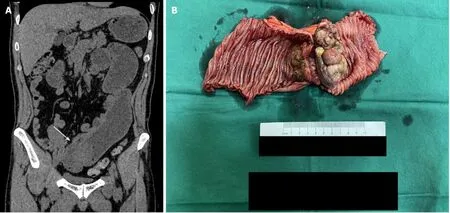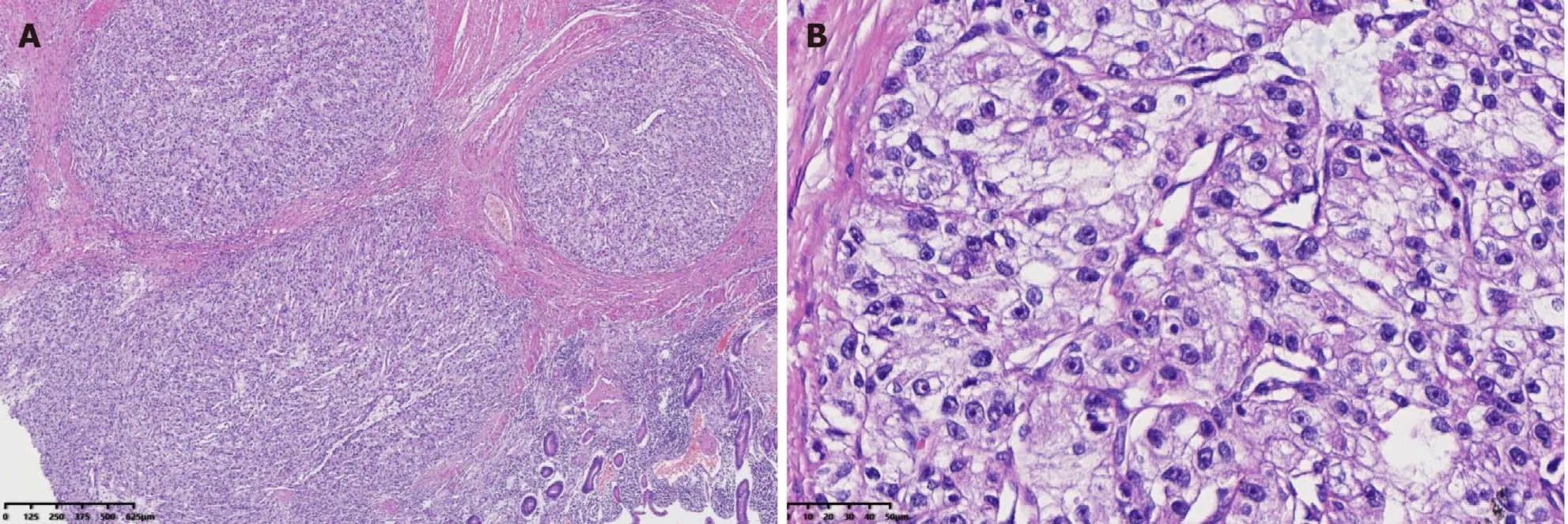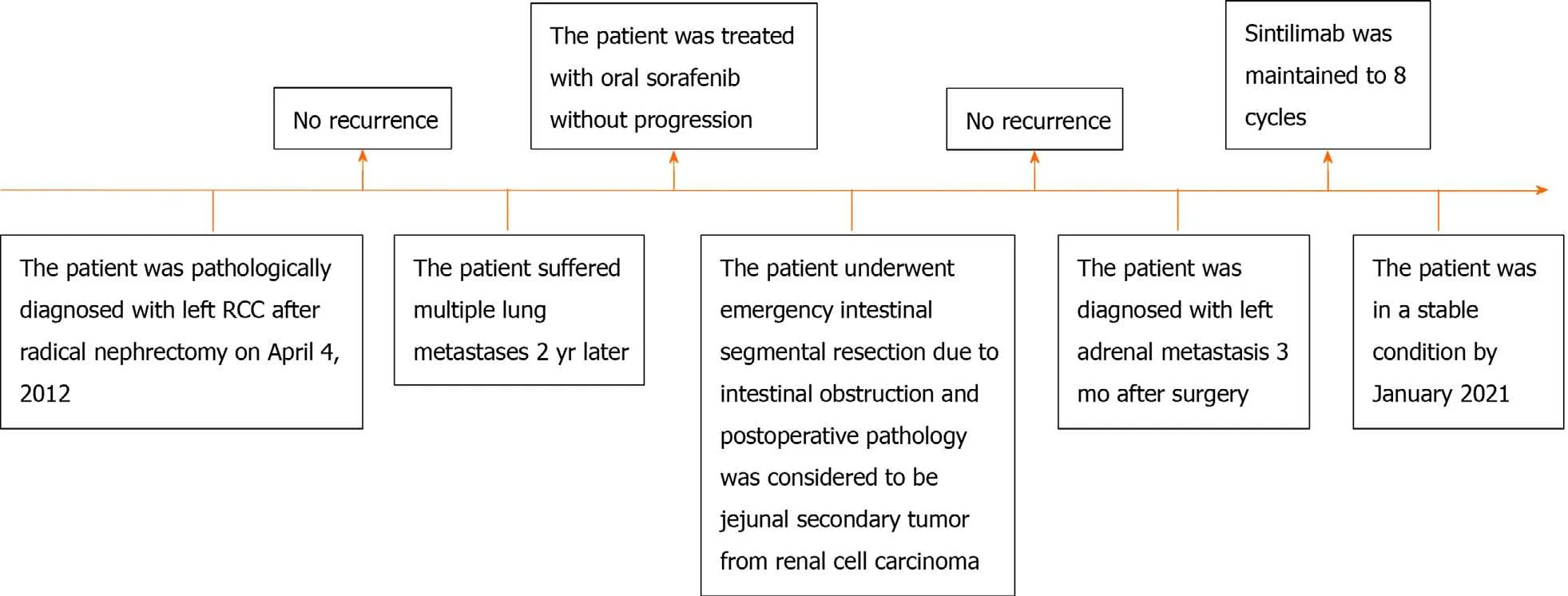Small bowel obstruction caused by secondary jejunal tumor from renal cell carcinoma: A case report
Gao-Chen Bai, Yue Mi, Yi Song, Jin-Rui Hao, Zhi-Song He, Jie Jin
Gao-Chen Bai, Yue Mi, Yi Song, Jin-Rui Hao, Zhi-Song He, Jie Jin, Department of Urology, Peking University First Hospital, Beijing 100034, China
Abstract BACKGROUND Secondary jejunal tumor from renal cell carcinoma (RCC) is extremely rare in clinical practice and is easily missed and misdiagnosed because of the low incidence and atypical symptoms.CASE SUMMARY A 38-year-old male patient was diagnosed pathologically with left RCC after radical nephrectomy in 2012. The patient then suffered multiple lung metastases 2 years later and was treated with oral sorafenib without progression for 6 years. In 2020, an emergency intestinal segmental resection due to intestinal obstruction was required, and postoperative pathology confirmed a jejunal secondary tumor from RCC. The patient had a smooth recovery following surgery. Three months after surgery, the patient was diagnosed with left adrenal metastasis, and subsequent sintilimab therapy has stabilized his condition.CONCLUSION This report is written to remind urologists and pathologists of the potential for small intestinal secondary tumors when a patient with a history of RCC seeks treatment for digestive symptoms. Enteroscopy and abdominal contrast-enhanced computed tomography are essential means of examination, but severe cases require immediate surgical intervention despite the lack of a preoperative examination to distinguish tumor attributes.
Key Words: Small bowel obstruction; Secondary jejunal tumor; Renal cell carcinoma;Surgery; Tumor metastasis; Case report
INTRODUCTION
Renal tumors are one of the most common tumors of the urinary system. Approximately 85% of renal tumors are renal cell carcinoma (RCC), and approximately 70%are clear cell histology[1]. Although the diagnosis and treatment of RCC are progressing rapidly, approximately 15% of RCC patients were diagnosed with metastases at the first visit[2], and approximately 20%-30% with localized RCC will experience recurrence after radical or partial nephrectomy[3]. Small intestinal secondary tumors from RCC occur infrequently. The most common symptoms are obstruction, anemia, pain, nausea, vomiting, weight loss, and other nonspecific malignancy symptoms[4], which are not specific and easily misdiagnosed. Additionally,postoperative surveillance of RCC may rarely be concerned about intestinal metastases, which are easy to ignore. Herein, we present a case of small bowel obstruction caused by a jejunal secondary tumor from RCC to review the characteristics of its diagnosis, treatment, and prognosis.
CASE PRESENTATION
Chief complaints
On March 8, 2020, a 38-year-old male patient presented to the emergency department with a 20-d history of reduced aerofluxus and defecation, accompanied by intermittent vomiting and abdominal colic.
History of present illness
The patient visited the hospital on July 30, 2012, presenting with a left renal tumor foundviaabdominal ultrasonography and computed tomography (CT). Laparoscopic radical nephrectomy was performed on August 4, 2012, and the postoperative pathology suggested a renal clear cell carcinoma measuring 6.0 cm × 6.0 cm × 5.5 cm(PT1b). The patient was diagnosed with pulmonary metastasis 2 years later through positron emission tomography-CT (PET-CT) and subsequently treated with oral sorafenib for 6 years without metastatic progression.
Personal and family history
The patient had no special personal and family history.
Physical examination
Physical examination revealed a surgical scar on the left waist, abdominal distension,and severe abdominal tenderness around the umbilicus with mild rebound tenderness.The liver and spleen were impalpable.
Imaging examinations
Abdominal CT revealed small intestinal obstruction caused by a large irregular mass in the jejunum lumen (Figure 1A). There was no time for further examinations such as enteroscopy and abdominal contrast-enhanced CT.

Figure 1 Imaging findings and postoperative specimen. A: Abdominal computed tomography showing small intestine obstruction caused by an irregular large mass in the lumen of the jejunum (white arrow); B: The postoperative specimen showing a cauliflower-like broad-based crunchy lesion measuring 6.5 cm × 5 cm× 5 cm.
FINAL DIAGNOSIS
The diagnosis was confirmed as small bowel obstruction due to a jejunal secondary tumor from RCC.
TREATMENT
Emergency segmental resection and end-to-end anastomosis of the small intestine were performed. The postoperative specimen was a cauliflower-like broad-based crunchy lesion measuring 6.5 cm × 5 cm × 5 cm (Figure 1B). The results of the histologic examination were consistent with metastatic renal clear cell carcinoma. The lesion presented as masses of clear tumor cells with small nuclei and abundant cytoplasm surrounded by a net-like fibrovascular stroma (Figure 2A and B). The patient had a smooth recovery following surgery.

Figure 2 Postoperative histologic examination. A and B: The results of the histologic examination were consistent with metastatic renal clear cell carcinoma.The lesion presented as masses of clear tumor cells with small nuclei and abundant cytoplasm surrounded by a net-like fibrovascular stroma (bars: A, 625 μm; B, 50 μm).
OUTCOME AND FOLLOW-UP
Three months after the small intestine surgery, PET-CT showed left adrenal metastasis from RCC (Figure 3). Then sintilimab (200 mg, every 21 d) was given to control the disease progression. The therapy was continued for eight cycles, and the patient was in a stable condition by January 2021.

Figure 3 The timeline picture of this case. RCC: Renal cell carcinoma.
DISCUSSION
Metachronous metastasis of RCC to the small intestine is a distinctly rare occurrence and is complicated by concomitant lung metastases and subsequent adrenal metastasis[5]. In a retrospective analysis of 44 small intestinal secondary tumors, colon cancer was the most common primary tumor (43.2%), followed by pancreatic and ovarian cancer (11.4% each). RCC accounted for only two in the study (4.5%)[6]. Furthermore,an autopsy report showed that in all 687 cases confirmed as RCC by histology, only two cases were found to have small intestinal metastases, accounting for 0.5% of the 392 metastatic cases[7].
In 15 patients with small intestinal metastases secondary to renal cancer, as summarized by Muelleret al[8], 5 patients presented with gastrointestinal bleeding, 5 with intussusception, 2 with small bowel obstruction, 1 with biliary obstruction, and 1 with both gastrointestinal bleeding and bowel obstruction. Therefore, for patients with a history of renal cancer, the possibility of small intestinal secondary tumors should be considered if the above symptoms are present. Either misdiagnosis or delayed treatment may endanger the health of the patients.
When seeing a patient with similar symptoms and a history of cancer, the disease's vital signs and severity should be assessed initially to determine the appropriate examination and treatment planning. Routine blood tests, liver function tests, bilirubin tests, stool occult blood tests, abdominal X-ray, especially enteroscopy, and abdominal contrast-enhanced CT are practical accessory examinations of diagnosing small bowel tumors and evaluating accompanying symptoms. Serum creatinine tests and other renal function evaluations are also indispensable for the operation history of primary renal tumor[9]. If the situation permits, a full-body imaging examination should be performed to exclude other possible metastatic lesions. In this case, preoperative diagnosis, which is essential for small bowel tumors, was not complete due to difficulty in applying enteroscopy and abdominal contrast-enhanced CT under emergency conditions.
Metastatic small bowel tumors should be differentiated from other malignant lesions such as adenocarcinoma, carcinoid, and lymphoma, the three most common cancers in the small intestine[10]. Valuable information for differential diagnosis can be obtained by examining the morphological features of the lesionviaimaging. Small intestinal adenocarcinoma classically presents with a short annular stricture. Carcinoid tends to infiltrate the mesentery, causing angulation, kinking, rigidity, and separation of small bowel loops. Lymphoma always presents as a non-obstructive lesion with wall thickening combined with lymphadenopathy and systematic symptoms[11,12].Metastatic cancers in the small bowel are usually large[13] and should be considered when the patient has a history of malignancy.
Since renal carcinoma is insensitive to chemotherapy and radiotherapy, resection of metastatic lesions is feasible and effective in patients with a previous nephr-ectomy[14]. Altet al[15] reported a retrospective study of 887 patients with confirmed RCC who underwent radical nephrectomies, where 125 patients who underwent complete surgical removal of all metastases had a longer cancer-specific median survival (4.8 yearsvs1.3 years;P﹤ 0.001). Palliative interventions, including enterostomy, bypass surgery, or urgent selective arterial embolization, may benefit the patients with unresectable small intestinal metastatic lesions accompanied by acute intestinal obstruction or bleeding[16,17]. For patients with multiple metastases who are not suitable for surgery, targeted therapy and immunotherapy have become first-line treatments with symptom relief and improved prognosis[18].
CONCLUSION
This case study has been presented to remind urologists and pathologists of the possibility of small intestinal secondary tumors when a patient with a history of RCC presents with digestive symptoms. Enteroscopy and abdominal contrast-enhanced CT are essential means of examination, but severe cases require immediate surgical intervention despite the lack of a preoperative examination to distinguish tumor attributes.
 World Journal of Clinical Cases2021年19期
World Journal of Clinical Cases2021年19期
- World Journal of Clinical Cases的其它文章
- Liver injury in COVID-19: Known and unknown
- Brugada syndrome associated with out-of-hospital cardiac arrest: A case report
- Ectopic opening of the common bile duct into the duodenal bulb with recurrent choledocholithiasis: A case report
- Glutamic acid decarboxylase 65-positive autoimmune encephalitis presenting with gelastic seizure, responsive to steroid: A case report
- Four-year-old anti-N-methyl-D-aspartate receptor encephalitis patient with ovarian teratoma: A case report
- Neuromuscular electrical stimulation for a dysphagic stroke patient with cardiac pacemaker using magnet mode change: A case report
